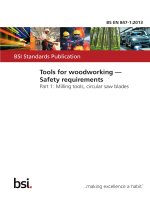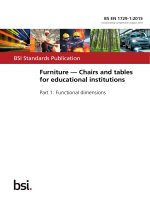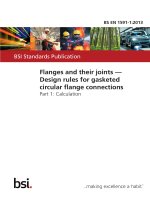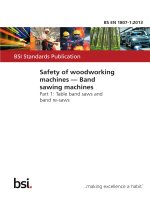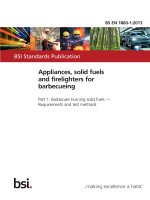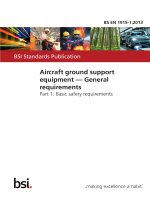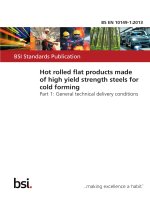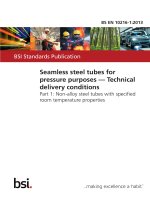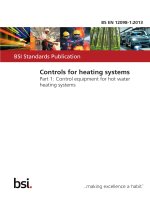Bsi bs en 61169 1 2013 (2016)
Bạn đang xem bản rút gọn của tài liệu. Xem và tải ngay bản đầy đủ của tài liệu tại đây (2.64 MB, 64 trang )
BS EN 61169-1:2013
Incorporating corrigendum February 2016
BSI Standards Publication
Radio-frequency connectors
Part 1: Generic specification — General
requirements and measuring methods
BS EN 61169-1:2013 BRITISH STANDARD
National foreword
This British Standard is the UK implementation of EN 61169-1:2013. It
is identical to IEC 61169-1:2013, incorporating corrigendum February
2016. It supersedes BS EN 61169-1:1996 which is withdrawn.
The UK participation in its preparation was entrusted to Technical
Committee EPL/46, Cables, wires and waveguides, radio frequency
connectors and accessories for communication and signalling.
A list of organizations represented on this committee can be obtained on
request to its secretary.
This publication does not purport to include all the necessary provisions of
a contract. Users are responsible for its correct application.
© The British Standards Institution 2016.
Published by BSI Standards Limited 2016
ISBN 978 0 580 93584 8
ICS 33.120.30
Compliance with a British Standard cannot confer immunity from
legal obligations.
This British Standard was published under the authority of the
Standards Policy and Strategy Committee on 30 November 2013.
Amendments/corrigenda issued since publication
Date Text affected
30 April 2016 Implementation of IEC corrigendum February 2016:
subclause 9.4.9.2 corrected
EUROPEAN STANDARD EN 61169-1
NORME EUROPÉENNE
EUROPÄISCHE NORM November 2013
ICS 33.120.30 Supersedes EN 61169-1:1994 + A1:1996 + A2:1997
English version
Radio-frequency connectors -
Part 1: Generic specification -
General requirements and measuring methods
(IEC 61169-1:2013)
Connecteurs pour fréquences Hochfrequenz-Steckverbinder -
radioélectriques - Teil 1: Fachgrundspezifikation -
Partie 1: Spécification générique - Allgemeine Anforderungen und
Exigences générales et méthodes de Messverfahren
mesure (IEC 61169-1:2013)
(CEI 61169-1:2013)
This European Standard was approved by CENELEC on 2013-08-14. CENELEC members are bound to comply
with the CEN/CENELEC Internal Regulations which stipulate the conditions for giving this European Standard
the status of a national standard without any alteration.
Up-to-date lists and bibliographical references concerning such national standards may be obtained on
application to the CEN-CENELEC Management Centre or to any CENELEC member.
This European Standard exists in three official versions (English, French, German). A version in any other
language made by translation under the responsibility of a CENELEC member into its own language and notified
to the CEN-CENELEC Management Centre has the same status as the official versions.
CENELEC members are the national electrotechnical committees of Austria, Belgium, Bulgaria, Croatia, Cyprus,
the Czech Republic, Denmark, Estonia, Finland, Former Yugoslav Republic of Macedonia, France, Germany,
Greece, Hungary, Iceland, Ireland, Italy, Latvia, Lithuania, Luxembourg, Malta, the Netherlands, Norway, Poland,
Portugal, Romania, Slovakia, Slovenia, Spain, Sweden, Switzerland, Turkey and the United Kingdom.
CENELEC European Committee for Electrotechnical Standardization
Comité Européen de Normalisation Electrotechnique
Europäisches Komitee für Elektrotechnische Normung
CEN-CENELEC Management Centre: Avenue Marnix 17, B - 1000 Brussels
© 2013 CENELEC - All rights of exploitation in any form and by any means reserved worldwide for CENELEC members.
Ref. No. EN 61169-1:2013 E
BS EN 61169-1:2013
EN 61169-1:2013
Foreword
The text of document 46F/216/CDV, future edition 2 of IEC 61169-1, prepared by SC 46F, "R.F. and
microwave passive components", of IEC TC 46, "Cables, wires, waveguides, R.F. connectors, R.F. and
microwave passive components and accessories" was submitted to the IEC-CENELEC parallel vote and
approved by CENELEC as EN 61169-1:2013.
The following dates are fixed:
• latest date by which the document has (dop) 2014-05-14
to be implemented at national level by (dow) 2016-08-14
publication of an identical national
standard or by endorsement
• latest date by which the national
standards conflicting with the
document have to be withdrawn
This document supersedes EN 61169-1:1994.
EN 61169-1:2013 includes the following significant technical changes with respect to EN 61169-1:1994:
Tests methods have been updated as well as terminology.
Attention is drawn to the possibility that some of the elements of this document may be the subject of
patent rights. CENELEC [and/or CEN] shall not be held responsible for identifying any or all such patent
rights.
Endorsement notice
The text of the International Standard IEC 61169-1:2013 was approved by CENELEC as a European
Standard without any modification.
In the official version, for Bibliography, the following notes have to be added for the standards indicated:
IEC 61196 series NOTE Harmonised in EN 61196 series.
ISO 286-1 NOTE Harmonised as EN ISO 286-1.
ISO 1302 NOTE Harmonised as EN ISO 1302.
ii
BS EN 61169-1:2013
EN 61169-1:2013
Annex ZA
(normative)
Normative references to international publications
with their corresponding European publications
The following documents, in whole or in part, are normatively referenced in this document and are
indispensable for its application. For dated references, only the edition cited applies. For undated
references, the latest edition of the referenced document (including any amendments) applies.
NOTE When an international publication has been modified by common modifications, indicated by (mod), the relevant EN/HD
applies.
Publication Year Title EN/HD Year
IEC 60027 Series EN 60027 Series
IEC 60050 Series Letter symbols to be used in electrical - -
IEC 60068-1 - technology EN 60068-1 -
IEC 60068-2-1 1990 EN 60068-2-11) 1993
IEC 60068-2-2 1974 International Electrotechnical Vocabulary EN 60068-2-22) 3) 1993
IEC 60068-2-6 - EN 60068-2-6 -
Environmental testing -
IEC 60068-2-11 - Part 1: General and guidance EN 60068-2-11 -
IEC 60068-2-13 - EN 60068-2-13 -
IEC 60068-2-14 2009 Environmental testing - EN 60068-2-14 2009
Part 2: Tests - Tests A: Cold
IEC 60068-2-17 - EN 60068-2-17 -
IEC 60068-2-20 - Environmental testing - EN 60068-2-20 -
Part 2: Tests - Tests B: Dry heat
IEC 60068-2-27 - EN 60068-2-27 -
Environmental testing -
IEC 60068-2-29 - Part 2-6: Tests - Test Fc: Vibration EN 60068-2-29 -4)
IEC 60068-2-30 - (sinusoidal) EN 60068-2-30 -
Environmental testing - iii
Part 2: Tests - Test Ka: Salt mist
Environmental testing -
Part 2: Tests - Test M: Low air pressure
Environmental testing -
Part 2-14: Tests - Test N: Change of
temperature
Environmental testing -
Part 2: Tests - Test Q: Sealing
Environmental testing -
Part 2-20: Tests - Test T: Test methods for
solderability and resistance to soldering heat
of devices with leads
Environmental testing -
Part 2-27: Tests - Test Ea and guidance:
Shock
Environmental testing -
Part 2: Tests - Test Eb and guidance: Bump
Environmental testing -
Part 2-30: Tests - Test Db: Damp heat, cyclic
(12 h + 12 h cycle)
1) EN 60068-2-1 is superseded by EN 60068-2-1:2007, which is based on IEC 60068-2-1:2007.
2) EN 60068-2-2 includes supplement(s) A to IEC 60068-2-2.
3) EN 60068-2-2 is superseded by EN 60068-2-2:2007, which is based on IEC 60068-2-2:2007.
4) EN 60068-2-29 is superseded by EN 60068-2-27:2009, which is based on IEC 60068-2-27:2009.
BS EN 61169-1:2013
EN 61169-1:2013
Publication Year Title EN/HD Year
IEC 60068-2-42 - Environmental testing - EN 60068-2-42 -
Part 2-42: Tests - Test Kc: Sulphur dioxide 1996
IEC 60068-2-52 1996 test for contacts and connections -
+ corr. July 1996
IEC 60068-2-54 - Environmental testing - EN 60068-2-52 1993
Part 2-52: Tests - Test Kb: Salt mist, cyclic -
IEC 60068-2-61 1991 (sodium chloride solution) -
IEC 60068-2-78 - Environmental testing - EN 60068-2-54 -
Part 2-54: Tests - Test Ta: Solderability -
IEC 60457-1 - testing of electronic components by the
wetting balance method Series
IEC 60617 Data- Series
IEC 61726 base Environmental testing - EN 60068-2-61 -
-
IEC 62037 Part 2: Test methods - Test Z/ABDM: Climatic
IEC 62153 Series
ISO 1000 Series sequence
-5)
Environmental testing - EN 60068-2-78
Part 2-78: Tests - Test Cab: Damp heat,
steady state
Rigid precision coaxial lines and their HD 351.1 S1
associated precision connectors -
Part 1: General requirements and measuring
methods
Graphical symbols for diagrams -
Cable assemblies, cables, connectors and EN 61726
passive microwave components - Screening
attenuation measurement by the reverberation
chamber method
Passive RF and microwave devices, EN 62037
intermodulation level measurement
Metallic communication cables test methods EN 62153
SI units and recommendations for the use of -
their multiples and of certain other units
iv
5) ISO 1000:1992 has been withdrawn.
– 2 – BS EN 61169-1:2013
61169-1 © IEC:2013(E)
CONTENTS
1 Scope...............................................................................................................................7
2 Normative references .......................................................................................................7
3 Terms and definitions .......................................................................................................8
3.1 General, parts of connectors ...................................................................................8
3.2 Basic connector terms .............................................................................................9
3.3 Constructional terms ............................................................................................. 10
3.4 Sealing .................................................................................................................. 11
3.5 Miscellaneous terms..............................................................................................11
3.6 General electrotechnical terms ..............................................................................12
4 Units, symbols and dimensions....................................................................................... 12
4.1 Units and symbols ................................................................................................. 12
4.2 Dimensions ........................................................................................................... 13
4.2.1 Details to be provided in relevant specifications ........................................13
4.2.2 Dimensional units to be used in specifications ...........................................13
5 Standards ratings and characteristics ............................................................................. 13
6 Classifications into climatic categories............................................................................13
7 IEC type designation ...................................................................................................... 14
8 Testing ........................................................................................................................... 14
9 Test methods.................................................................................................................. 14
9.1 Mechanical inspection ........................................................................................... 14
9.1.1 Visual inspection ....................................................................................... 14
9.1.2 Dimensions................................................................................................ 15
9.2 Electrical tests and measuring procedures ............................................................15
9.2.1 Return loss ................................................................................................ 15
9.2.2 Power rating .............................................................................................. 19
9.2.3 Contact resistance, outer conductor and centre conductor continuity
(mated cabled connectors) ........................................................................20
9.2.4 Centre and outer conductor contact continuity under severe
mechanical conditioning ............................................................................22
9.2.5 Insulation resistance..................................................................................22
9.2.6 Voltage proof ............................................................................................. 23
9.2.7 Screening effectiveness.............................................................................24
9.2.8 Discharge test (corona test).......................................................................24
9.2.9 Intermodulation level (PIM) ........................................................................25
9.2.10 Surge withstand.........................................................................................26
9.3 Mechanical tests and measuring procedures .........................................................26
9.3.1 General ..................................................................................................... 26
9.3.2 Soldering ................................................................................................... 26
9.3.3 Vibration .................................................................................................... 26
9.3.4 Insertion force (resilient contacts) ..............................................................27
9.3.5 Centre contact captivation ......................................................................... 28
9.3.6 Engagement and separation forces and torques ........................................28
9.3.7 Effectiveness of clamping device against cable rotation (nutation of
cable end) ................................................................................................. 29
9.3.8 Effectiveness of clamping device against cable pulling ..............................29
BS EN 61169-1:2013 – 3 –
61169-1 © IEC:2013(E)
9.3.9 Effectiveness of clamping device against cable bending ............................30
9.3.10 Effectiveness of clamping device against cable torsion ..............................31
9.3.11 Strength of coupling mechanism ................................................................32
9.3.12 Safety wire hole pull-out bending moment (and shearing force) .................32
9.3.13 Bump.........................................................................................................33
9.3.14 Shock ........................................................................................................ 34
9.3.15 Mechanical endurance...............................................................................35
9.4 Climatic conditionings and tests ............................................................................35
9.4.1 Conditionings ............................................................................................ 35
9.4.2 Climatic sequence .....................................................................................36
9.4.3 Damp heat, steady state ............................................................................37
9.4.4 Change of temperature ..............................................................................37
9.4.5 High temperature endurance .....................................................................38
9.4.6 Low temperature endurance ......................................................................39
9.4.7 Sealing non-hermetic sealed connectors....................................................40
9.4.8 Hermetically sealed connectors .................................................................40
9.4.9 Water immersion test................................................................................. 41
9.4.10 Salt mist .................................................................................................... 43
9.4.11 Resistance to solvents and contaminating fluids ........................................43
9.4.12 Sulphur dioxide test ...................................................................................45
10 Quality assessment ........................................................................................................ 46
10.1 General ................................................................................................................. 46
10.2 Quality assessment steps......................................................................................46
10.2.1 Primary stage of manufacture ....................................................................46
10.2.2 Structurally similar components .................................................................46
10.2.3 General principle for obtaining quality conformance...................................46
10.3 Test schedule and inspection requirements ...........................................................46
10.3.1 Acceptance tests ....................................................................................... 46
10.3.2 Periodic tests............................................................................................. 48
10.4 Procedures for quality conformance ......................................................................49
10.4.1 Quality conformance inspection .................................................................49
10.4.2 Quality conformance and its maintenance..................................................49
10.5 Test and measurement procedures .......................................................................49
10.5.1 General ..................................................................................................... 49
10.5.2 Schedule of basic test groupings for acceptance and periodic tests ...........50
10.6 Specifications ........................................................................................................ 50
10.6.1 Specification structures ............................................................................. 50
10.6.2 Sectional specification (SS) ....................................................................... 50
10.6.3 Detail specification (DS) ............................................................................ 50
10.6.4 Blank detail specification ........................................................................... 51
10.6.5 Blank detail specification pro-forma for XXXX connectors ..........................52
11 Marking .......................................................................................................................... 57
11.1 Marking of component ........................................................................................... 57
11.2 Marking and contents of package ..........................................................................57
Annex A (informative) Simulated sea-water solution for use with salt mist test (marine
environment, see 9.4.10.3) ............................................................................................. 58
Bibliography.......................................................................................................................... 59
– 4 – BS EN 61169-1:2013
61169-1 © IEC:2013(E)
Figure 1 – graphical symbols ................................................................................................ 16
Figure 2 – General principle.................................................................................................. 16
Figure 3 – Measuring set-up for two-connector procedure.....................................................17
Figure 4 – Example of a time domain reflectometer measurement recording .........................18
Figure 5 – Equipment set-up for the measurement of reflection in time domain .....................19
Figure 6 – Possible test arrangements ..................................................................................23
Figure 7 – Measuring circuit for the discharge test ................................................................25
Figure 8 – Test arrangement for nutation ..............................................................................29
Figure 9 – Test arrangement for pulling ................................................................................30
Figure 10 – Bending.............................................................................................................. 31
Figure 11 – Cable torsion...................................................................................................... 31
Figure 12 – Temperature curve profile ..................................................................................41
Figure 13 – Container/jumper arrangement ...........................................................................42
Table 1 – Preferred climatic categories (see IEC 60068-1)....................................................13
Table 2 – Dielectric materials ratings ....................................................................................20
Table 3 – Severities for vibration........................................................................................... 27
Table 4 – Recommended severities for bump........................................................................33
Table 5 – Recommended severities for shocks .....................................................................34
Table 6 – Recommended severities for low temperature tests ...............................................39
Table 7 – Fuels, lubricants, hydraulic fluids and anti-freeze agents .......................................44
Table 8 – Cleaning agents and moisture repellents ...............................................................44
Table 9 – Acceptance tests ................................................................................................... 47
Table 10 – Periodic tests ...................................................................................................... 48
BS EN 61169-1:2013 – 7 –
61169-1 © IEC:2013(E)
RADIO FREQUENCY CONNECTORS –
Part 1: Generic specification –
General requirements and measuring methods
1 Scope
This part of IEC 61169, which is a generic specification, relates to radio frequency connectors
for r.f. transmission lines for use in telecommunications, electronics and similar equipment.
It provides the basis for the sectional standards, which apply to individual connector types. It
is intended to establish uniform concepts and procedures concerning:
– terminology;
– standard ratings and characteristics;
– testing and measuring procedures concerning electrical, mechanical and climatic
properties;
– classification of connectors with regard to climatic testing procedures involving
temperature and humidity.
The test methods and procedures of this standard are intended for acceptance and type
approval testing.
2 Normative references
The following documents, in whole or in part, are normatively referenced in this document and
are indispensable for its application. For dated references, only the edition cited applies. For
undated references, the latest edition of the referenced document (including any
amendments) applies.
IEC 60027 (all parts), Letter symbols to be used in electrical technology
IEC 60050 (all parts), International Electrotechnical Vocabulary (available from:
)
IEC 60068-1, Environmental testing – Part 1: General and guidance
IEC 60068-2-1:1990, Environmental testing – Part 2-1: Tests – Test A: Cold1
IEC 60068-2-2:1974, Environmental testing – Part 2-2: Tests – Test B: Dry heat2
IEC 60068-2-6, Environmental testing – Part 2-6: Tests – Test Fc: Vibration (sinusoidal)
IEC 60068-2-11, Environmental testing – Part 2-11: Tests – Test Ka: Salt mist
IEC 60068-2-13, Environmental testing – Part 2-13: Tests – Test M: Low air pressure
IEC 60068-2-14:2009, Environmental testing – Part 2-14: Tests – Test N: Change of
temperature
IEC 60068-2-17, Environmental testing – Part 2-17: Tests – Test Q: Sealing
_____________
1 This publication has been withdrawn.
2 This publication has been withdrawn.
– 8 – BS EN 61169-1:2013
61169-1 © IEC:2013(E)
IEC 60068-2-20, Environmental testing – Part 2-20: Tests – Test T: Test methods for
solderability and resistance to soldering heat of devices with leads
IEC 60068-2-27, Environmental testing – Part 2-27: Tests – Test Ea and guidance: Shock
IEC 60068-2-29, Environmental testing – Part 2: Tests – Test Eb and guidance: Bump
IEC 60068-2-30, Environmental testing – Part 2-30: Tests – Test Db: Damp heat, cyclic (12 h
+ 12 h cycle)
IEC 60068-2-42, Environmental testing – Part 2-42: Tests – Test Kc: Sulphur dioxide test for
contacts and connections
IEC 60068-2-52:1996, Environmental testing – Test Kb: Salt mist, cyclic (sodium, chloride
solution)
IEC 60068-2-54, Environmental testing – Part 2-54: Tests – Test Ta: Solderability testing of
electronic components by the wetting balance method
IEC 60068-2-61:1991, Environmental testing – Part 2-61: Test methods – Test Z/ABDM:
Climatic sequence
IEC 60068-2-78, Environmental testing – Part 2-78: Tests – Test Cab: Damp heat, steady
state
IEC 60457-1, Rigid precision coaxial lines and their associated precision connectors – Part 1:
General requirements and measuring methods
IEC 60617, Graphical symbols for diagrams (available from: />
IEC 62153 (all parts), Metallic communication cables test methods
IEC 61726, Cable assemblies, cables, connectors and passive microwave components –
Screening attenuation measurement by the reverberation chamber method
IEC 62037 (all parts), Passive RF and microwave devices, intermodulation level measurement
ISO 1000, SI units and recommendations for the use of their multiples and of certain other
units 3
3 Terms and definitions
For the purposes of this document, the following terms and definitions apply.
NOTE Some of the terms defined are not used in the present document, but may be used in the different sectional
specifications.
3.1 General, parts of connectors
3.1.1
contact (electrical)
state in which individual electrically conductive parts are in such close mechanical touch as to
provide a low resistance path to electrical current in either direction
3.1.2
contact
conductive element in a component which mates with a corresponding element to provide an
electrical path (to provide electrical contact)
_____________
3 This publication has been withdrawn.
BS EN 61169-1:2013 – 9 –
61169-1 © IEC:2013(E)
3.1.3
male (pin) contact
contact intended to make electrical engagement on its outer surface and which will enter a
female (socket) contact
3.1.4
female (socket) contact
contact intended to make electrical engagement on its inner surface and which will accept
entry of a male (pin) contact
3.1.5
hermaphroditic contact
contact which is intended to mate with an identical contact
3.1.6
resilient contact
contact having elastic properties to provide a force to its mating part
3.2 Basic connector terms
3.2.1
connector
component normally attached to a cable or mounted on a piece of apparatus (excluding an
adaptor) for electrically joining separable parts of a transmission line system
3.2.2
connector pair
two connectors having complementary mating faces and locking means, so as to be mateable
and interlockable
3.2.3
series type
terms characterizing the particular mating faces and locking means of a connector pair with
regard to construction and dimension
Note 1 to entry: The term "series" is sometimes used as an approximate synonym of 'type' for designating the
entirety of connector styles with identical mating face and locking means.
3.2.4
style
particular form or shape of connector, as well as a combination of connectors of the same
type
Note 1 to entry: For "adaptor", see 3.5.1 to 3.5.5: a 'within-type adaptor" may also be considered as a particular
style of a given type.
Note 2 to entry: Examples are: free and fixed connectors, both straight and right angle, within-type adaptors
straight and right angle.
3.2.5
variant
variation of a style, in particular details, such as cable-entry dimensions
3.2.6
grade
qualification of a connector with regard to mechanical and electrical precision in particular
with respect to a defined return loss
3.2.7
general purpose connector: Grade 2
connector making use of the widest permitted dimensional deviations (tolerances) so as still
to guarantee minimum stated performance and intermateability
Note 1 to entry: A requirement for the return loss may or may not be specified.
– 10 – BS EN 61169-1:2013
61169-1 © IEC:2013(E)
3.2.8
high performance connector: Grade 1
connector for which limits of return loss are specified as a function of frequency.
Note 1 to entry: No tighter dimensional tolerances than those applicable to Grade 2 are normally specified. The
manufacturer is responsible, however, for choosing tighter tolerances where necessary to ensure that the return
loss requirements are met.
3.2.9
standard test connector: Grade 0
precisely made connector of a particular type used to carry out return loss measurements on
Grade 1 and Grade 2 connectors, contributing only negligible errors to the measuring result
Note 1 to entry: The standard test connector is often part of an inner-type adaptor which allows connection with a
precision connector forming part of the measuring equipment.
3.2.10
precision connector
connector that has coincident mechanical and electrical reference planes, air dielectric, and
has the property of making connections with a high degree of repeatability without introducing
significant reflections, loss or leakage
Note 1 to entry: It is intended for mounting on air-lines and instruments. Precision connectors can be of the
hermaphroditic type, flange type or of the pin and socket type as stated in IEC 60457-1.
3.2.11
laboratory precision connector
LPC
precision connector without dielectric support for the centre conductor
3.2.12
general precision connector
GPC
precision connector with self-contained dielectric support capable of supporting the un-
supported centre conductor of an LPC and standard air-line which it is mated
3.3 Constructional terms
3.3.1
male connector/pin connector
connector containing a male (pin) centre contact
3.3.2
female connector/socket connector
connector containing a female (socket) centre contact
3.3.3
plug connector
connector featuring the active part of the coupling mechanism, i.e. the nut or bayonet ring,
and which normally is a free contact
Note 1 to entry: Depending on the particular type, a plug may be a male or female connector.
3.3.4
socket
connector complimentary to the plug
3.3.5
hermaphroditic connector
connector which mates with an identical connector
3.3.6
free connector
connector for attachment to a free end of a cable
Note 1 to entry: If not specified as fixed, a connector is assumed to be free.
BS EN 61169-1:2013 – 11 –
61169-1 © IEC:2013(E)
3.3.7
fixed connector
connector with provision for attachment to a mounting surface
3.3.8
triaxial
transmission line comprising three concentric conductors having a common axis and with
each conductor insulated from the other two
3.4 Sealing
3.4.1
sealed connector
connector employing a seal capable of fulfilling specified gas-, moisture- or liquid tightness
requirements
3.4.2
barrier seal
seal preventing the passage of gases, moisture or liquids in an axial direction within the body
shell of a connector
3.4.3
panel seal
seal preventing the passage of gases, moisture or liquids between the fixed connector or
adaptor body shell and the panel via the mounting hole(s)
Note 1 to entry: The sealing member is often provided as a discrete item.
3.4.4
mating face seal
seal preventing the passage of gases, moisture or liquids into the interface space of a pair of
mated connectors
3.4.5
hermetic seal
seal meeting the requirements specified on application of Test Qk of IEC 60068-2-17
3.5 Miscellaneous terms
3.5.1
adaptor
two-port device for joining two transmission lines having non-mating connectors
3.5.2
fixed adaptor
adaptor with provision for attachment to a mounting surface
Note 1 to entry: If not specified as fixed, an adaptor is assumed to be free.
3.5.3
within-type adaptor
adaptor for use between two or more connectors all of the same type
3.5.4
inter-type adaptor
adaptor for use between two or more connectors of different types
3.5.5
standard test adaptor
inter-type adaptor for test purposes, having a standard test connector at one end and a
precision connector at the other end
– 12 – BS EN 61169-1:2013
61169-1 © IEC:2013(E)
3.5.6
standard air line
homogenous air dielectric transmission line having the smallest possible irregularities in
diameter and straightness of conductors, no self-contained supports for the inner conductor
and using non-magnetic material with good conductivity
3.5.7
reference line
air-line similar to the standard air-line but with dielectric support of the inner conductor, and
with a design such that the internal return loss is kept at a minimum within the frequency
range made use of for measurements
3.5.8
proof coupling torque
maximum torque to be applied to the screw-coupling mechanism of a specific connector
series for testing the mechanical strength of the coupling mechanism
3.5.9
normal coupling torque
maximum/minimum values of torque to be applied in normal use to the coupling of screw type
connectors
3.5.10
engagement and separation torque
torque required to overcome friction, compression of springs, etc. during the engagement and
separation of connectors with rotary type coupling mechanisms before or after complete
engagement
Note 1 to entry: This is intended to check for undue tightness of threads, burrs on bayonet-cams, freedom of
rotation of coupling rings, etc.
3.5.11
push-on
connectors with interfaces that engage/disengage in an axial direction
3.6 General electrotechnical terms
3.6.1
nominal value
typical value used to designate or identify a component, device or equipment
Note 1 to entry: It follows from the definition that a nominal value is not subject to tolerances.
Note 2 to entry: Typical and nominal are interchangeable.
3.6.2
limiting value
in a specification, the greatest and/or smallest admissible value of one of the quantities
3.6.3
rated value
operational values that are provided in the detailed specification
4 Units, symbols and dimensions
4.1 Units and symbols
Units, graphical symbols, letter symbols and terminology shall whenever possible, be taken
from the following IEC publications:
60027: Letter symbols to be used in electrical technology.
60050: International Electrotechnical Vocabulary (IEV).
60617: Graphical symbols for diagrams.
BS EN 61169-1:2013 – 13 –
61169-1 © IEC:2013(E)
Other publication:
ISO 1000: SI units and recommendations for the use of their multiples and of certain other
units.
4.2 Dimensions
4.2.1 Details to be provided in relevant specifications
Each relevant specification shall provide the following.
a) Sufficient dimensional information on the mating faces of connectors should be provided
to ensure intermateability and compliance with performance requirements.
b) Information on the connector envelope maximum dimensions shall be provided to enable
the user to accommodate the connectors in their equipment.
c) The relevant specification is not intended to restrict details of construction which do not
affect interchangeability or performance, nor are they to be used as manufacturing
drawings.
4.2.2 Dimensional units to be used in specifications
The dimensions and tolerances shall be given in metric units.
During conversion of dimensions given in inches into millimetres, they shall, in principle, be
rounded to the nearest 0,001 mm or 0,000 05 in. Where, however, mechanical and electrical
considerations permit, the rounding shall usually be to the nearest 0,01 mm or 0,000 5 in.
5 Standards ratings and characteristics
The ratings and characteristics applicable to each connector type and style shall be stated in
the relevant specification. They should normally cover:
a) a short description of the connector construction stating in particular the inner diameter of
the outer conductor and, if applicable, the preferable cable types to be used with the
connector;
b) the return loss as a function of frequency for the different grades (if applicable) together
with the conditions for which it is valid;
c) the working voltage at different altitudes (pressures);
d) the climatic categories;
e) any other rating or characteristic applicable.
6 Classifications into climatic categories
The classification of connectors with regard to climatic conditions is based on IEC 60068-1
and indicated by a series of three sets of digits separated by oblique strokes corresponding
respectively to tests at low temperature (minus sign not shown), high temperature and the
number of days of exposure to damp heat, steady state.
The climatic severities are referenced by a cold temperature, high temperature and damp heat
steady state duration. Examples of climatic category of this are shown in Table 1:
Table 1 – Preferred climatic categories (see IEC 60068-1)
Category designation Letter Temperature range Damp heat steady state
–40 °C to +85 °C 21 days
40/85/21 A –55 °C to +125 °C 21 days
–55 °C to +155 °C 56 days
55/125/21 B
55/155/56 C
– 14 – BS EN 61169-1:2013
61169-1 © IEC:2013(E)
7 IEC type designation
The purpose of the IEC type designation is to identify a particular connector within the scope
of IEC r.f. connector standardization. It is not intended to include information in excess of this.
In practice, it is usually necessary to identify a manufacturer's product because, although
complying with the IEC standard, there may be features not covered by the standard.
Connectors complying with the relevant specification shall be designated by the following
indications and in the order given:
a) the number of the specification;
b) the letters "IEC";
c) additional identification as indicated in the relevant specification.
NOTE When an IEC type designation is used, either for the marking of the product or in a description of the
product, it is the responsibility of the manufacturer to ensure that the item meets the requirements of the relevant
specification.
8 Testing
Unless otherwise specified, the following conditions shall apply:
a) tests shall be carried out under standard atmospheric conditions for testing as specified in
IEC 60068-1;
b) before measurements are made, the connectors shall be preconditioned under standard
atmospheric conditions for testing for a time sufficient to allow the entire connector to
reach thermal stability;
c) recovery conditions for the interval after a conditioning and the next measurement of test
shall be in accordance with IEC 60068-1.
The test schedule is shown in 10.3 and details of conditioning in 9.4.1.
When a nominal value only is given for an applied stress and/or the duration of application,
the specified value shall be taken to indicate the minimum test severity to be applied.
The test shall be carried out with connectors – as received from the supplier. In no case shall
the contact parts be cleaned or otherwise prepared prior to tests, unless explicitly stated in
the specification.
If it is required that a cable shall be attached to a connector, this shall be done in accordance
with the connector manufacturer's instructions.
Mated sets of connectors shall be fully engaged and screw-coupled connectors shall be
tightened to the normal coupling torque quoted in the relevant specification.
In the case of mounted connectors subjected to environmental conditioning, care shall be
taken to ensure that the back-of-panel portion of such fixed connectors, when appropriate, is
protected.
For tests involving exposure to extreme temperatures, a cable with appropriate temperature
capability should be used.
9 Test methods
9.1 Mechanical inspection
9.1.1 Visual inspection
Visual inspection shall include a check on
a) the marking: it shall be correct in accordance with 11.1 and be legible after any of the
specified tests;
b) the manufacture: it shall have been carried out in a careful and workmanlike manner;
BS EN 61169-1:2013 – 15 –
61169-1 © IEC:2013(E)
c) deterioration after electrical, mechanical and climatic tests: unless otherwise specified,
there shall be no visible deterioration likely to affect the performance;
d) the marking on the package: it shall be in accordance with 11.1.
9.1.2 Dimensions
9.1.2.1 General
The dimensions shall be checked and shall comply with those specified by the relevant
specification.
Any suitable method may be used except that gauges shall be used when specified by the
relevant specification.
9.1.2.2 Mechanical compatibility
The dimensions of the mating face shall be in accordance with the mating face drawings
prescribed in the relevant specification. Use of compatibility gauges is optional. When used,
specimens shall accept the gauges.
9.2 Electrical tests and measuring procedures
9.2.1 Return loss
9.2.1.1 General considerations
Return loss is useful for quantifying the level (amount) of the reflected signal due to the
deviation from the nominal impedance and structural effects of the connector, which is useful
when system performance is the primary interest.
The return loss of connectors shall be measured with the test specimen mated with a
standard test connector. Adaptors shall be mated with standard test connectors on both sides.
The relevant specification for a particular connector shall also specify the pertinent standard
test connector (connector of Grade O). Mated pairs of standard test connectors shall exhibit
closest uniformity of characteristic impedance throughout the pair inclusive of the transitions
to precision lines or cables.
Cable connectors shall be attached to an appropriate cable in accordance with the
instructions supplied by the connector manufacturer. The cable to be used shall preferably be
of the close tolerance type.
9.2.1.2 Frequency domain test s-parameter measurements using
9.2.1.2.1 Test equipment
A vector network analyzer (VNA) capable of performing
calibration standards (open, short, load) is recommended.
A vector network analyser is a test system that enables the RF performance of radio
frequency (RF) and microwave devices to be characterised in terms of network scattering
parameters, or S parameters.
The return loss of the connector(s) under test shall be measured with the VNA over the
specified frequency range of interest.
A detailed description of the error correction (calibration) procedure is given in the manual of
the VNA.
Precision test connectors with small inherent reflections (see note below) shall be fitted on
both ends of the test specimen to allow direct connection to the network analyzer, analyzer
test leads and/or, terminating load.
NOTE Small inherent reflections ≤ 1,035:1 VSWR.
– 16 – BS EN 61169-1:2013
61169-1 © IEC:2013(E)
9.2.1.2.2 Procedure
The two-connector procedure uses cable of a known value attached to the connector.
Time domain reflectometry (TDR) shall be used to check the homogeneity of the measuring
set-up, to localize imperfections and to examine the accuracy of the characteristic impedance
of the sections of coaxial lines used.
When available on the network analyser, gating will be performed for removing errors due to
the cable.
The procedure is illustrated in Figures 2 and 3.
The interconnecting cable of the connectors shall consist either of a prescribed cable of
verified performance or an adequate cable simulator.
As a check of the accuracy of the system, it is recommended to repeat the measurements
with the connector assembly reversed between the standard test connectors.
The typical return loss graphical symbols are described in Figure 1:
Time domain reflectometer Mated male and female (pin and socket)
equipment connectors
Frequency domain reflectometer Not necessarily exactly matched
equipment connectors
Mated precision hermaphroditic Precision termination
connectors
IEC 1631/13
Figure 1 – graphical symbols
Connectors Precision
under test termination
Standard Standard IEC 1632/13
test adaptor test adaptor
See NOTE See NOTE
Figure 2 – General principle
NOTE Standard tests connectors are either directly used on the analyzer port, analyzer test leads and/or the
precision termination or are connected through standard test adaptors.
BS EN 61169-1:2013 – 17 –
61169-1 © IEC:2013(E)
Test method Notes
Purpose
Reference air Standard air line Termination
Selection and line
verification of
reference line by Adaptors need
comparison with be neither
standard air line precision or
calibrated
Selection and
verification of
transmission line for
use during
subsequent
measurements by
comparison with
reference line
Verification of
performances of
standard test
adaptors
Routine equipment Verification of
check equipment and
termination
Additional errors
equipment check
Verification of
Verification of overall error
performance of
standard test Standard test
adaptors (1,2,3 and adaptors may
4) also be
checked cross-
coupled and
reversed
IEC 1633/13
Figure 3 – Measuring set-up for two-connector procedure
9.2.1.3 Method of time domain reflectometry (TDR)
9.2.1.3.1 Theoretical considerations
Assuming the incident signal has the ideal form of a step function, the reflected s(f) = r(t) is
converted to the complex return loss as a function of frequency by:
r ( ω ) j ω T s(t ) e j ωt dt
0
where 0 to T is the time interval comprising the portion of s(t) due to the reflection arising
from the connector under test.
